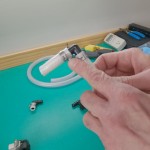This post may contain affiliate links.
Welcome back, everyone!
This is the next video in our “RV Basics” series, where I try to give you the talks I wish I had gotten when we started RVing. These videos are not very technical at all, and if you’re a new RVer, they should make things a lot less stressful as you try to figure your systems out that first time.
In this one, we’re going to tackle the basics of your RV’s fresh water plumbing system. This is one of those things that makes RVing so much more comfortable than other styles of camping and traveling – having running water with you, wherever you go. It’s not complicated at all, so everyone should be able to follow along, regardless of the make, model, type, or age of your RV.
Our friends at Winnebago sponsored this video, along with all the videos in my “RV Basics” series, so thank you Winnebago! They want you all to be educated and ready to hit the road without any extra stress. Hope you’ll check out the other videos, too:
RV BASICS SERIES:
➡️ Understanding RV Electrical
➡️ Introduction to Waste Water Plumbing
➡️ Dry Camping and Boondocking Best Practices
Any questions, sound off below and I’ll do my best to answer!











I wanted to share a great tip I got from Paul Pritts on the Storyteller FB page. The sanitization instructions for STO call for premixing a bleach/water solution.
The mixing device below (repurposed from a marine application) makes it much easier to get the bleach solution into your freshwater tank without risk of getting bleach everywhere.
Car Wash Sprayer and Boat Engine Flush Kit | Water Hose Mixer to Get Salt Away and Off Your Boat and Flusher for Boat Motor Muffs on Outboards & Boats I/O and Soap Spray Car Cleaning Hose Adapter
Your link didn’t come through, but I think this is the product you were trying to link to: https://amzn.to/3UzlkyO
Which is more or less the same idea as the “RV Inline Sanitizer”, which is what we use: https://amzn.to/3QhUMzt
(So obviously, I think products like these are a good idea!)
I will say though… it was quite a bit less expensive when we bought ours.
Hi James,
Great video! We just downsized to a Winnebago Travato (which we love) but it’s the first time we have not had a gravity fill for the fresh water. We love to Boondock (and unfortunately frequently don’t have access to a water spigot). Any suggestions for how to refill the tank from a water container?
Is your Travato newer? If it has a water center control panel (with a bunch of levers on it), you should be able to set the levers to siphon water into the fresh water tank from the hose input. Then you take a short length of hose and put it into your jug (as you would antifreeze) and it will pump the water into the fresh tank.
A great job, as usual. One thing you didn’t touch on is pros/cons of only turning on the pump when needed and not leaving city water on all the time. I know this is kind of debatable but I’ve seen enough minor drip, drip, drip, leaks turn into troublesome puddles that I never leave the lines pressurized. This is particularly true with city water – with the pump, you will hear it “burp” from time to time if there is a leak but there’s no such warning with city water.
Thanks, Graham – and I agree with you!
In our own personal RV, we *never* hook up to city water and always use water from our on-board tank. Besides the reason you mentioned, this also keeps the water in the onboard tank turning over and fresh, AND prevents an accidental overfill of the grey tank.
I didn’t include it in the video because it’s technically not necessary to know or do that in order for a beginner to use their RV.
It’s a good habit though.
Great stuff James.
Basic but for someone who might not have ever had to dive into some repairs on an RV, stuff like this is gold.
I bought a used truck camper in 1985. Loved that unit, but zero information came with it, had to learn through the school of hard knocks.
I have a story for you for when you do the Black Tank episode…
A *lot* of us have black tank stories! lol!
Can’t wait.